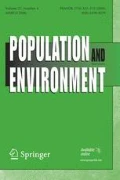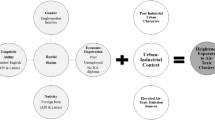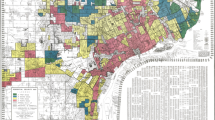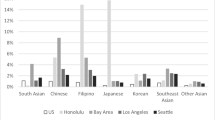Abstract
To explore intra-ethnic diversity in patterns of environmental health injustice in Miami (Florida), we related modeled estimates of cancer risks from on-road pollutants from the 2005 National-scale Air Toxics Assessment with 2005–2009 American Community Survey tract-level sociodemographic data. Neighborhoods with lower incomes and higher proportions of Hispanics were at risk. When disaggregating “Hispanic” based on country of origin, we found that Cuban and Colombian neighborhoods faced significantly increased cancer risk from vehicular air pollution while Mexican neighborhoods faced significantly decreased risk. These divergent patterns of environmental injustice based on Hispanic country-of-origin groupings have been shaped by the differing migration and settlement patterns of Hispanic subgroups in Miami. Our findings highlight the growing need to consider racial/ethnic heterogeneity in future EJ analysis and policy.




Similar content being viewed by others
Notes
We use the term Hispanic, as opposed to Latino, in this paper as it is more commonly used in Florida.
References
Anselin, L. (2005). Exploring spatial data with GeoDa: A workbook (pp. 1–244). Urbana, IL: University of Illinois, Urbana-Champaign.
Anselin, L., Syabri, I., & Kho, Y. (2006). GeoDa: An introduction to spatial data analysis. Geographical Analysis, 38, 5–22.
Apelberg, B. J., Buckley, T. J., & White, R. H. (2005). Socioeconomic and racial disparities in cancer risk from air toxics in Maryland. Environmental Health Perspectives, 113(6), 693–699.
Bonilla-Silva, E., Fortman, T. A., Lewis, A. E., & Embrick, D. G. (2003). ’It Wasn’t Me!’: How will race and racism work in the 21st century America? Political Sociology, 12, 111–134.
Brown, P. (1995). Race, class and environmental health: A review and systematization of the literature. Environmental Research, 69(1), 15–30.
Brulle, R. J., & Pellow, D. N. (2006). Environmental justice: Human health and environmental inequalities. Annual Review of Public Health, 27, 103–124.
Chakraborty, J. (2009). Automobiles, air toxics, and adverse health risks: Environmental inequities in Tampa Bay, Florida. Annals of the Association of American Geographers, 99(4), 674–697.
Chakraborty, J., & Maantay, J. (2011). Proximity analysis for exposure assessment in environmental health justice research. In J. A. Maantay & S. McLafferty (Eds.), Geospatial analysis of environmental health (pp. 111–138). New York: Springer.
Chakraborty, J., Maantay, J., & Brender, J. D. (2011). Disproportionate Proximity to environmental health hazards: Methods, models, and measurement. American Journal of Public Health, 101(S1), S27–S36.
Collins, T., Grineski, S., Chakraborty, J., & McDonald, Y. (2011). Understanding environmental health inequalities through comparative intracategorical analysis: Racial/ethnic disparities in cancer risks from air toxics in El Paso County, Texas. Health and Place, 17, 335–344.
Environmental Protection Agency (2009) National-scale air toxics assessment: 2002 assessment results. Retrieved August 21, 2009 from http://www.epa.gov/ttn/atw/nata2002/tables.html.
Environmental Protection Agency (2011a) 2005 NATA: Glossary of key terms. Retrieved May 21, 2012 from http://www.epa.gov/ttn/atw/natamain/gloss1.html.
Environmental Protection Agency (2011b, March 11) 2005 National-scale air toxics assessment. Retrieved July 4, 2011 from http://www.epa.gov/ttn/atw/nata2005/index.html.
Environmental Protection Agency (2011c) An overview of methods for EPA’s national-scale air toxics assessment. Retrieved May 21, 2011 from http://www.epa.gov/ttn/atw/nata2005/05pdf/nata_tmd.pdf.
Environmental Protection Agency (2012) Environmental justice: Basic information. Retrieved October 3, 2012 from http://www.epa.gov/environmentaljustice/basics/index.html.
FHWA (2008) State and metro-level vehicle miles traveled data. Retrieved July, 2008 from http://www.njfuture.org/Media/Docs/VMTDataforStatesandCities.pdf.
Grineski, S. E., Collins, T., Chakraborty, J., & McDonald, Y. (2012). Environmental health injustice: Exposure to air toxics and children’s respiratory hospital admissions. The Professional Geographer. doi:10.1080/00330124.2011.639625.
Gunier, R., Hertz, A., Von Behren, J., & Reynolds, P. (2003). Traffic density in California: Socioeconomic and ethnic differences among potentially exposed children. Journal of Exposure Analysis and Environmental Epidemiology, 13, 240–246.
Haller, W., & Landolt, P. (2005). The transnational dimensions of identity formation: Adult children of immigrants in Miami. Ethnic and Racial Studies, 28(6), 1182–1214. doi:10.1080/01419870500224554.
Hankivsky, O., Reid, C., Cormier, R., Varcoe, C., Clark, N., Benoit, C., et al. (2010). Exploring the promises of intersectionality for advancing women’s health research. International Journal for Equity in Health, 9(5), 1–15.
Humes, K. R., Jones, N. A., & Ramirez, R. R. (2011). Overview of race and Hispanic origin: Census 2010 (p. 24). Washington, DC.
Hunter, L. (2000). The spatial association between US immigrant residential concentration and environmental hazards. International Migration Review, 34(2), 460–488.
Jerrett, M., Burnett, R. T., Kanaroglou, P., Eyles, J., Finkelstein, N., Giovis, C., et al. (2001). A GIS-environmental justice analysis of particulate air pollution in Hamilton, Canada. Environment and Planning A, 33(6), 955–973.
Kissling, W. D., & Carl, G. (2008). Spatial autocorrelation and the selection of simultaneous autoregressive models. Global Ecology and Biogeography, 17, 59–71.
Linder, S. H., Marko, D., & Sexton, K. (2008). Cumulative cancer risk from air pollution in Houston: Disparities in risk burden and social disadvantage. Environmental Science and Technology, 42(12), 4312–4322.
Lopez, M. H., & Dockterman, D. (2011). US Hispanic country-of-origin counts for nation, top 30 metropolitan areas. Washington, DC: Pew Hispanic Research Center.
Mohai, P., Pellow, D. N., & Roberts, J. T. (2009). Environmental justice. Annual Review of Environment and Resources, 34, 405–430.
Mohl, R. A. (2004). Stop the road: Freeway revolts in American cities. Journal of Urban History, 30(5), 674–706.
Nijman, J. (2011). Miami: Mistress of the Americas. Philadelphia: University of Pennsylvania.
Office of Air Quality Planning and Standards (2011) An overview of methods for EPA’s national-scale air toxics assessment. Retrieved October 5, 2012 from www.epa.gov/ttn/atw/nata2005/05pdf/nata_tmd.pdf.
Padin, J. A. (2005). The normative mulattoes: The press, Latinos, and the racial climate on the moving immigration frontier. Sociological Perspectives, 48, 49–75.
Pastor, M., Morello-Frosch, R., & Sadd, J. L. (2005). The air is always cleaner on the other side: Race, space, and ambient air toxics exposures in California. Journal of Urban Affairs, 27(2), 127–148.
Pearce, J. R., Richardson, E. A., Mitchell, R. J., & Shortt, N. K. (2010). Environmental justice and health: The implications of the socio-spatial distribution of multiple environmental deprivation for health inequalities in the United Kingdom. Transactions of the Institute of British Geographers, 35(4), 522–539. doi:10.1111/j.1475-5661.2010.00399.x.
Schultz, A. J., & Mullings, L. (Eds.). (2005). Gender, race, class and health: Intersectional approaches. Hoboken, NJ: Jossey-Bass.
Suro, R., & Singer, A. (2002). Latino growth in metropolitan America: Changing patterns, new locations (pp. 1–18). Washington, DC: Center on Urban & Metropolitan Policy and The Pew Hispanic Center.
US Census Bureau (2008) A compass for understanding and using American community survey data. Washington, DC.
Woltman, K., & Newbold, K. B. (2009). Of flights and flotillas: Assimilation and race in the Cuban diaspora. Professional Geographer, 61(1), 70–86. doi:10.1080/00330120802520244.
Acknowledgments
This study is based upon work supported by the National Science Foundation (NSF) under Grants No. CMMI-1129984/1130191, “Collaborative Research: Advancing environmental equity research: vulnerability to air pollution and flood risks in Houston and Miami” at the University of Texas-El Paso and the University of South Florida, Tampa. It was also supported by Award Number P20MD002287-05S1 from the National Institute on Minority Health and Health Disparities at the University of Texas-El Paso. Any opinions, findings, and conclusions or recommendations expressed in this paper are those of the authors and do not necessarily reflect the views of the NSF, the National Institute on Minority Health and Health Disparities or the National Institutes of Health, or the Environmental Protection Agency.
Author information
Authors and Affiliations
Corresponding author
Rights and permissions
About this article
Cite this article
Grineski, S.E., Collins, T.W. & Chakraborty, J. Hispanic heterogeneity and environmental injustice: intra-ethnic patterns of exposure to cancer risks from traffic-related air pollution in Miami. Popul Environ 35, 26–44 (2013). https://doi.org/10.1007/s11111-012-0184-2
Published:
Issue Date:
DOI: https://doi.org/10.1007/s11111-012-0184-2




